Introduction
Customers thoroughly research products and compare prices before buying an item. Ecommerce stores need to apply sophisticated methods and tools to identify products customers want and offer them at the right moment.
Sales techniques, like cross-sells and upsells, help merchants persuade customers to buy additional or more expensive products.
Find out how cross-sells and upsells work and use them to increase the average transaction size in your store.
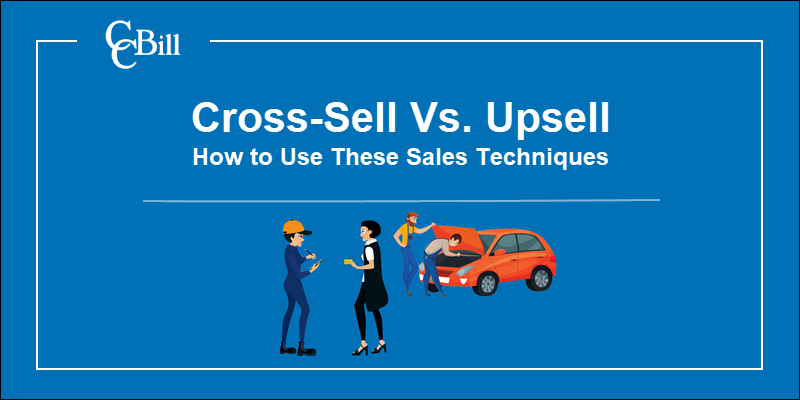
Cross-Sell Vs. Upsell: What's the difference?
Upselling enables merchants to sell products with high-profit margins, while cross-sells help increase the average order value.
Online stores typically use both sales techniques but prioritize one depending on their business model.
What are Cross-Sells?
Cross-selling encourages customers to buy a related product in addition to the product they are currently viewing. Using cross-sells benefits both merchants and customers:
- By increasing the average order value.
- Reducing shipping costs.
- Provides a better shopping experience than buying each product separately.
- Complements the primary product and reinforces its long-term value.
For example, if a customer wants to buy a bicycle, offering protective gear, like a cycling helmet makes sense.
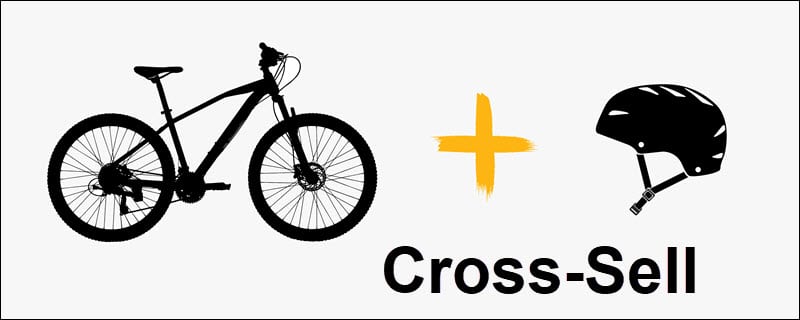
Ecommerce stores that sell lots of smaller items utilize cross-selling to maximize the average order value and reduce fixed shipping costs.
What are Upsells?
An upsell presents customers with a better and more expensive alternative product. Successful upsells result in:
- Higher profit margins.
- Average transactions are larger.
- The high-priced item is more likely to fulfill customer expectations.
An electric bike may be more beneficial to a customer that commutes every day than a conventional bicycle.
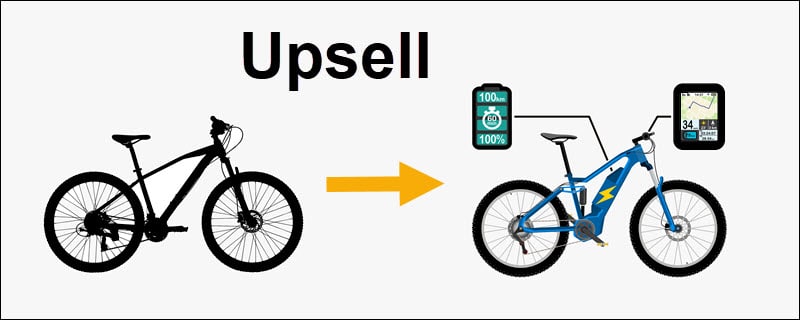
Businesses that sell high-end products can increase their profit margins considerably by encouraging customers to buy the more expensive alternative.
How to Upsell Successfully
Use the following guidelines to carry out a successful upsell strategy:
- Pricing - Do not offer products with a substantially higher price point. Customers may perceive upsell products as unattainable if they cost 20% more than the item they are currently viewing.
- Displaying Upsells - Upsells on every page are going to ruin the customer's shopping experience. Allow the customer to show significant interest in a product before offering an alternative. Businesses usually display upsells late in the purchasing funnel, during checkout, or on approval pages. Payment processors provide in-built features, like CCBill's Upsale Promotions, enabling merchants to display upsells directly on payment forms and approval pages.
- Offer Relevant Products - Ecommerce stores typically attempt to upsell to the next higher model or display the best sold or reviewed products. Do not display wide arrays of unfamiliar and irrelevant products and ensure that the upsell product is always within the scope of the customer's interests.
- Personalization - Collect and analyze customer data to customize upsell offers and make relevant suggestions. For example, you can offer return customers loyalty discounts on upsells. You can also use collected data to avoid displaying products the customer already purchased in the past.
Note: Learn more about how to upsell properly.
Example of Upselling
Companies that sell consumer electronics, computers, and mobile devices use upsells to great effect.
Hewlett Packard's website gradually guides the customer to the checkout page by offering multiple customizations along the way. Each customization is an opportunity to display upsells.
If customers want to buy a laptop, they cannot immediately add it to the shopping cart. The customer first needs to review the available options for the product.
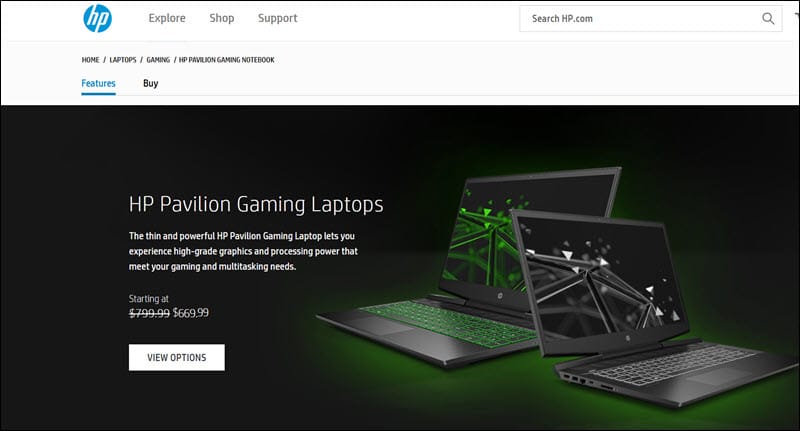
The options page allows customers to explore more advanced versions of the same laptop model.
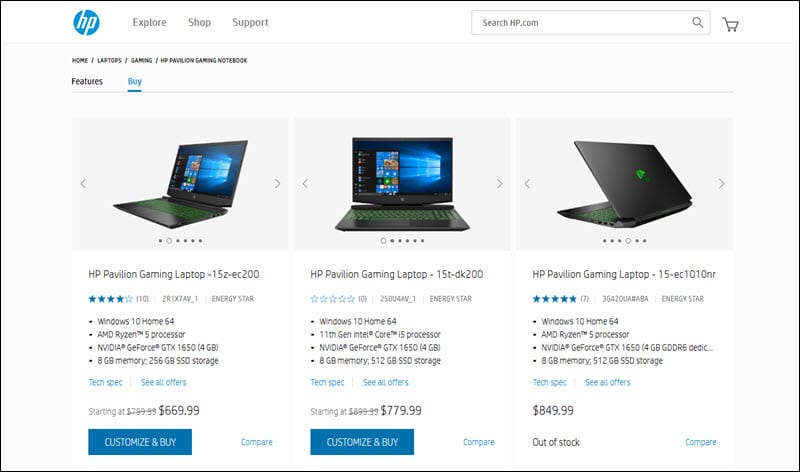
Once customers decide to buy a specific model, they need to configure the laptop. HP uses this opportunity to upsell by offering better processors, operating systems, graphic cards, etc.
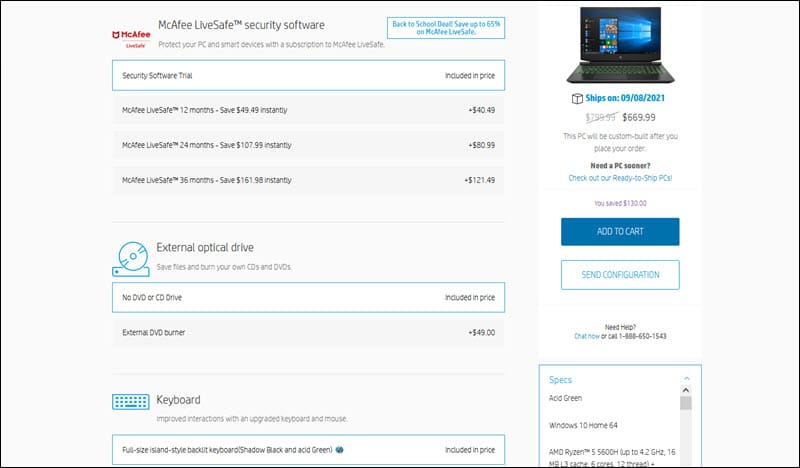
Some customers may consider this approach to be tedious and that it needlessly extends the payment process.
However, the nature of the product and the detailed customization options serve a specific purpose. This upsell strategy works because it is fully and seamlessly integrated into the customer's shopping experience.
How to Cross-Sell Successfully
To set up compelling and effective cross-sells:
- Only Promote Related Products - Customers quickly become frustrated by a barrage of pointless product offerings. Use categories, attributes, and tags to establish relationships between products. Identify and offer complementary items that are frequently bought together.
- Keep Prices Low - The price of a cross-sell product should be significantly lower than the price of the original product. Customers need to be instantly drawn and buy the additional product on an impulse. Consider implementing dynamic pricing to match or beat competitor prices in real-time.
- Automation- It can be challenging to maintain large product catalogs, customize offers, and display cross-sells manually. Use automated software solutions like plugins to extend your ecommerce platform and stay competitive. For example, there are many free plugins that can help you show related products in WooCommerce.
- Connect with Other Merchants - To elevate the customer's experience, explore different options and cross-sell products or services from other websites or stores. Solutions like Merchant Connect can provide more opportunities for merchants when establishing cross-sells.
Example of Cross-Selling
IKEA is famous for focusing on utility, design, and simplicity. It applies the same approach to cross-sells in their online store.
A large side panel appears with potential cross-sale offers once a customer adds a product to the cart. In this example, the system recognizes that the chosen product is an electric blind.
The cross-sell includes a Gateway to connect smart devices like blinds, light bulbs, and speakers and control them with an IKEA mobile app.
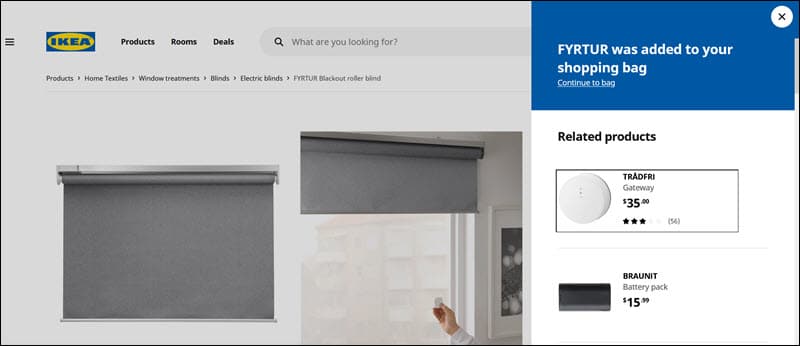
The cross-sell offer also includes a rechargeable battery pack that can be connected to the electric blind. Customers need to actively close the cross-sell side panel to continue browsing the website.
This is a good example of how cross-sells reinforce the company's core values and mission.
Conclusion
You know how upsells and cross-sells work. Use them to promote the ideal product at the right moment and add real value for your customers.
To increase the average order value in your store, you need to focus on customer data, automate processes, and personalize cross-sell and upsell offers.
